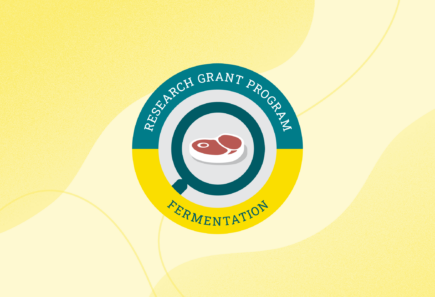
Plant-based marbled meats
Years active: 2023This project aims to address a critical gap in the production of meat alternatives by developing marbled plant-based meats.

This project aims to address a critical gap in the production of meat alternatives by developing marbled plant-based meats.

The project aims to design practical variations of extruder cooling dies and study the impacts of cooling gradient, die dimensions, and mass flow rates.

Development of sustainable production technology for the manufacturing of high-quality chicken mushroom mycelium as a future meat substitute.

Integrating high-moisture extrusion and post-structuring technologies for improved textures from plant proteins.
There is a limited number of edible non-animal scaffold materials that are naturally adhesive for use in cultivated meat production. Identifying a larger and more diverse set of these materials, which tend to be inexpensive and accessible, and characterizing their industrial scalability, environmental impact, and effects on food properties supports progress towards cultivated meat price parity.
Growth factors (GFs) can be incorporated into scaffolds as a strategy for both reducing costs and improving product quality of cultivated meat. Open-access research is needed to test the feasibility of this strategy and determine the most appropriate methods.
The inclusion of fat and marbling in cultivated meat is likely to increase its flavor, texture, and consumer appeal. Structural approaches using edible microcarriers, hydrogels, and 3D bioprinting present promising options to support fat cell growth and reduce buoyancy in culture for integrating fat into cuts of meat, but more research is needed to optimize conditions.
A variety of plant-based scaffolds present the opportunity to combine the natural nutritional and structural benefits of plants with the taste and high protein of cultivated meat. Bacterial nanocellulose from coconut water is a particularly promising scaffold material with its FDA approval status and beneficial nutritional and cell adhesion properties.
Stretching of engineered muscle constructs has been previously demonstrated to induce alignment and maturation of muscle fibers, which is desirable for whole cut cultivated meat. Stretch stimuli could also be incorporated into a semi-continuous bioprocess in which a piece of tissue is expanded over time and portions of the tissue periodically harvested. The large amount of meat produced could offset the high initial cost of fabricating a construct capable of continuous growth.
Cultivated seafood will need to be supplemented with long-chain omega-3 polyunsaturated fatty acids to be nutritionally equivalent or superior to conventional seafood. However, how these compounds can best be incorporated has not been determined, and there are several potentially-viable strategies. Further research is needed to determine which strategies are most cost-effective and scalable and whether there are appreciable differences between methods in the quality of the final product.